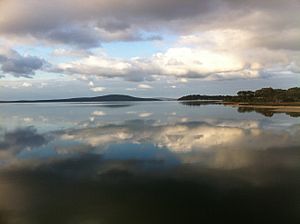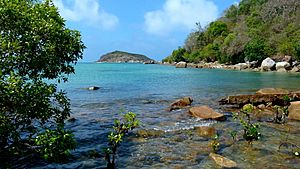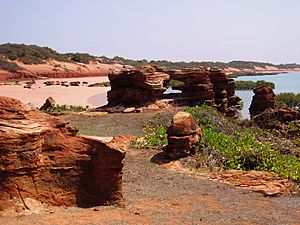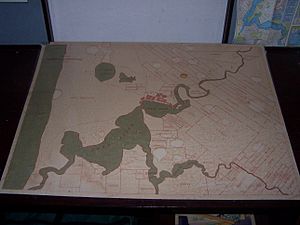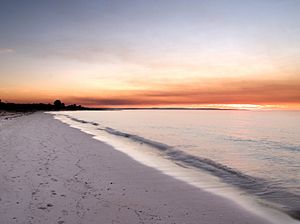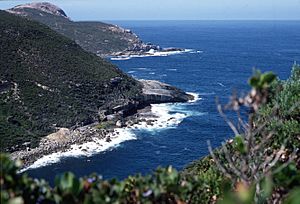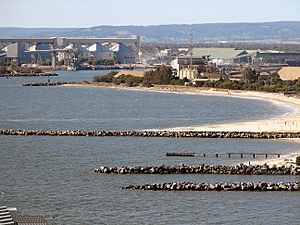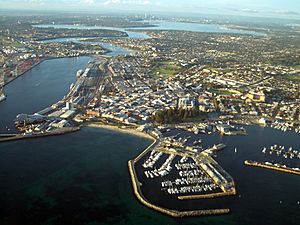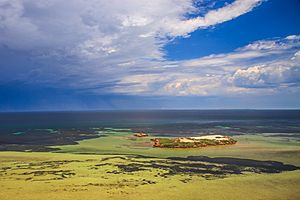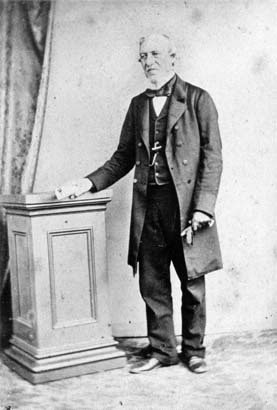John Septimus Roe facts for kids
Quick facts for kids
John Septimus Roe
|
|
|---|---|
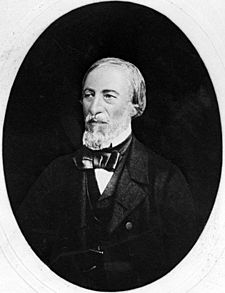
John Septimus Roe, 1850s
|
|
| Born | May 8, 1797 |
| Died | May 28, 1878 Perth, Western Australia
|
| Occupation | Surveyor |
| Spouse(s) | Matilda Bennett |
John Septimus Roe (born May 8, 1797 – died May 28, 1878) was a very important person in the early history of Western Australia. He was the first Surveyor-General of the colony. This meant he was in charge of mapping and planning the land.
He was also a famous explorer. For almost 40 years, he was a member of Western Australia's Legislative and Executive Councils. These were important government groups that helped make decisions for the colony.
Contents
Early life
John Septimus Roe was born in Newbury, Berkshire, England, on May 8, 1797. He was the seventh son of James Roe, who was a rector (a type of priest) in Newbury.
When he was ten, John went to Christ's Hospital School in London. He was meant to study to become a school teacher. However, he was very good at mathematics. Because of this, he was chosen to train at the Mathematical School. This school prepared students for service in the Royal Navy (the British navy).
John was an excellent student. At 15, he began his training with the Navy.
Exploring the Coasts of Australia
John Roe's first survey trip was in 1817. He was an assistant to Captain Philip Parker King. Their job was to map the northern and north-west coasts of Australia. They sailed from Sydney Harbour on a ship called the Mermaid.
In January 1818, while at King George Sound, Roe almost drowned. He was trying to go all the way around Oyster Harbour in the Kalgan River.
Later, Roe was allowed to name a bay on the north-west coast. He named it Nickol Bay after a man who had fallen overboard. Captain King also named a point on a peninsula Mount Roe in Roe's honor. The Mermaid returned to Sydney in July.
At the end of 1818, the Mermaid sailed to Van Diemen's Land (now Tasmania). They surveyed the Derwent River and the eastern coast. They finished this easy task and were back in Sydney by February 1819.
The next trip, in 1819, was planned to last eight or nine months. Their mission was to properly survey the northern coast. After leaving Sydney, the Mermaid sailed around Cape York. They then explored and mapped the coast and islands of Arnhem Land. They also surveyed Bathurst Island and discovered Cambridge Gulf. They continued mapping the coast as far as the Bonaparte Archipelago. They stopped in Timor for supplies and then returned to Sydney.
Roe's next journey in 1820 was also meant to survey the north coast. But they faced very bad weather soon after leaving Sydney. The Mermaid's bowsprit (a pole at the front of the ship) broke. The ship had to return to Sydney with water leaking inside.
After repairs, they set off again. Near Goulburn Island, Roe was surprised by local people and barely escaped. As they continued west, the Mermaid leaked so badly that King decided to careen her. This means tilting the ship on its side to fix the hull. They did this at a bay now called Careening Bay. Even after repairs, the ship still leaked. So, they decided to return to Sydney by sailing along the west and south coasts. In York Sound, they found two rivers. One was named Roe River after Roe's father.
When they returned to Sydney, the Mermaid was too damaged to sail again. A new ship, the Bathurst, replaced her. In May 1821, Roe sailed on the Bathurst for another expedition. They sailed north along the coast. On June 30, while at Cairncross Island, Roe had an accident. The ropes holding the fore top-mast stay-sail (a type of sail) were accidentally let go. Roe, who was at the top of the masthead (the very top of the mast) holding them, fell 15 metres (50 feet) onto the deck. He was knocked out but not seriously hurt. He recovered quickly. However, in later years, he believed this accident caused him to lose sight in his right eye.
Despite his accident, the expedition continued to the west coast. They mapped the coast as far as Roebuck Bay. In August, they sailed to Mauritius. After three weeks there, they went south to King George Sound. Then they sailed north up the west coast, mapping as they went. Finally, they returned to Sydney. During this trip, Roe was promoted to lieutenant.
Back in Sydney, Roe mapped Sydney Harbour. His boat capsized on August 19, 1822, and four people died. But he still finished the survey. The British Navy published his map in 1826. Soon after, Roe returned to England on the Bathurst, arriving in June 1823.
Roe received his next job on February 2, 1824. He was told to return to Australia on a ship called the Tamar. The Tamar arrived in Sydney in July. The next month, it was sent to help start a new settlement at Melville Island. The settlement officially began on October 21. Soon after, the Tamar sailed to Bombay (now Mumbai) for repairs and supplies. The ship then spent time mapping and doing navy duties between Ceylon, India, and Rangoon. Britain was at war with Burma at the time. Roe's work in the Burma War was recognized when he received the Burma Medal in 1827. After other trips, the Tamar returned to England in November.
Becoming Surveyor-General of Western Australia
Back in England, Roe rested and visited his family. He also spent time with Matilda Bennett, who would become his wife. He was interested in becoming the Surveyor-General of New South Wales. But he found out that job was already taken.
However, he was soon offered the job of Surveyor-General of Western Australia. This was for a new settlement planned at the Swan River. Roe accepted, but only if it was a civilian job, as he wanted to leave the navy.
After accepting the job, Roe had little time to prepare. The official group was leaving soon on a ship called the Parmelia. Roe quickly proposed to Matilda Bennett, and they got married. The Roes boarded the Parmelia on February 3, 1829.
The Parmelia arrived at the Swan River on June 1, 1829. Roe immediately started mapping the harbor, river, and land nearby. He suggested the locations for Perth and Fremantle, and he was in charge of designing these towns. By April of the next year, 36 ships had brought settlers to the new colony.
Exploring Western Australia
John Septimus Roe led many exploration trips between 1829 and 1849.
Here are some of his important explorations:
- In June 1829, he explored the Swan and Canning Rivers.
- In January 1830, he explored the area around Leschenault, and several rivers like the Collie, Ferguson, and Preston. He also explored Cape Naturaliste and Geographe Bay.
- In November 1831, he explored around Albany, Doubtful Island Bay, Torbay, Wilsons Inlet, the Kalgan River, and Kojonup.
- In 1832, he explored around the Hotham and Williams Rivers.
- In 1834, he explored to Pinjarra on the Murray River. Then he went to Bunbury, Kojonup, Albany, and back to Perth. An important event happened near Pinjarra during this trip.
- In 1835, he explored the area around Moorilup on the Kalgan River. He also explored the Hay and Sleeman Rivers.
- In October and November 1835, he was part of the Great Southern Expedition. This trip explored the land between Perth and Albany using two different paths. The goal was to find the best route for a road.
- In October and November 1836, he explored land 180 miles east and 100 miles north from Perth.
- In December 1837, he discovered and mapped Peel Harbour and Warnbro Sound.
- In January 1838, he explored the coast between the Swan River and Cape Naturaliste.
- In June 1838, he explored from the Swan River to Bunbury. He traveled along the Murray, Harvey, Collie, and Preston Rivers. Then he returned along the base of the Roe and Darling Ranges.
- In May 1839, he traveled through unknown land to rescue three starving men. They were part of George Grey's difficult trip to Shark Bay.
- In December 1839, he traveled overland with Governor Hutt to Albany and back, using new paths.
- In June 1847, he explored the area around and north of Champion Bay.
- From September 1848, he led a five-month trip. He explored from the Avon River to the Stirling Range, and then east to the Russell Range and Cape Pasley on the south coast. He also explored 60 to 100 miles inland. He returned by different routes. On this trip, he found coal on the Fitzgerald and Phillips Rivers. Roe was seriously hurt on this expedition. After this, he did not go on any more major trips.
Roe also encouraged and guided many other explorers. These included Robert Dale, Augustus and Francis Gregory, Robert Austin, Charles Hunt, and John Forrest. Because of his own explorations and the ones he inspired, Roe is sometimes called the "father of Australian explorers."
Later life and legacy
Roe retired in 1871. He was 73 years old and had worked for the colony for over 40 years. He was already blind in one eye. Over the next five years, he became weaker. He passed away on May 28, 1878.
One of Roe's most important contributions was setting aside the land for Kings Park. While others helped a lot, Roe was clearly responsible for first putting aside this special area.
Roe was the first president of the Swan River Mechanics' Institute. He held this job until he died. Both the Western Australian Museum and the State Library of Western Australia grew from this Institute. Roe's large collection of scientific items became the start of the museum's collection. Because of this, some people say Roe founded both institutions.
During his time as Surveyor-General, Roe tried to copy every exploration journal in Western Australia. His book, Letterbook of Explorers' Journals, still exists today. Thanks to him, Western Australia has very good records of its early explorations. Almost every important journal from 1827 until Roe retired in 1870 is still available.
In 1955, the State Library received a large collection of Roe's log books, diaries, and letters. This collection is one of the most important private collections ever given to the library.
Many places and things are named after John Septimus Roe:
- The town of Roebourne, Western Australia, to honor his work.
- Mount Roe was named for him by Philip Parker King.
- Roelands, a town near Bunbury.
- The Roe River was also named after him by King.
- The Roe Highway, a major road in Perth.
- A poisonous plant found near Muntadgin, Western Australia was named Roe poison. This was because Roe had found it earlier near York.
- Roe Street in Perth.
- The electoral district of Roe in the Legislative Assembly of Western Australia. This area covers a region from Lake Grace to Esperance.
- John Septimus Roe Anglican Community School in Mirrabooka, named in his honor in 1992.
- Caladenia roei, a type of Orchid.
Images for kids


